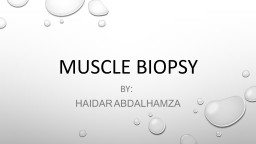

Abdalhamza Types of muscle fibers What is a muscle biopsy is a surgical procedure in which a small sample of muscle is taken and examined It is considered to be minor surgery and is usually conducted as a day case under local anaesthetic ID: 1007171
Download Presentation The PPT/PDF document "MUSCLE BIOPSY By : Haidar" is the property of its rightful owner. Permission is granted to download and print the materials on this web site for personal, non-commercial use only, and to display it on your personal computer provided you do not modify the materials and that you retain all copyright notices contained in the materials. By downloading content from our website, you accept the terms of this agreement.
1. MUSCLE BIOPSYBy :Haidar Abdalhamza
2.
3. Types of muscle fibers:
4. What is a muscle biopsy?is a surgical procedure in which a small sample of muscle is taken and examined.It is considered to be “minor” surgery, and is usually conducted as a day case, under local anaesthetic.usually requested after a physical examination, blood tests, and an EMG (electromyography).Introduced by Duchenne – 1868Simple but invasive procedure
5. indicationsInvestigation of muscle weakness )static & progressive (To diff bet. Myogenic /neurogenic cause of weakness.Patients suspected of having inflammatory myopathy & collagen vascular diseasesMetabolic diseases where muscle is likely to be affected.Suspected drug induced myopathy.In asymptomatic carrier of genetic diseases.To assess the disease progress and prognosis
6. Biopsy is low-yield in :Electrolyte disturbancesEndocrine diseasesMalignant hyperthermiaMyasthenic syndromes Prior TraumaPeriodic paralysisPoor nutrition
7. TechniqueSelection of Muscle :1) Moderately affected or muscle in which disease is evolving should be selected.2) Ideal site- Quadriceps / biceps.3) Bx should be taken from belly of muscle, away from tendinous insertion.4) In autopsy cases, Bx can be taken upto 12 hrs.
8. techniqueAvoid1) Severely / minimally affected muscle2) Previously injured site- by EMG, intramuscular injection3) If rhabdomyolysis occurred, wait for3 months
9. typesNeedle Biopsy This involves inserting a needle, about 5mm in diameter, into the muscle. When the needle is removed a small sample of muscle remains inside the needle and this is taken for analysis.Open Biopsy This involves making an incision a few centimetres long but the size is kept to a minimum.
10. Needle Muscle Biopsy Procedure ¤The following muscles are readily and safely accessible by needle muscle biopsy: Vastus Lateralis: Most commonly and most easily biopsied muscle because of its size. ☆Site of biopsy: With subject supine, make sure leg is positioned so that toes are pointing upwards. Palpate vastus and mark a spot typically about 4-6 inches proximal to the patella and just lateral to the femur. Enter perpendicularly with the needle for sampling.Biceps: Typically the lateral head of the biceps in the mid-section of the biceps muscle. Requires entry into the biceps at an angle (about 45 degrees or less).
11.
12. Needle biopsy ◇Advantages :Less traumaticsimple ◇Particularly for:biochemical investigationFollow up Bx to monitor the progress of treatment. ◇Disadvantage:Small size of BxDifficulty in orientation of tissue.
13. Open muscle biopsyBlock the area regionally with 1% lidocaine, and make a 1.5-cm incision through the skin and subcutaneous tissues.Carefully split the enveloping fascia to expose clearly the muscle bundles from which the biopsy specimen is to be taken.Using a special double clamp or silk sutures approximately 2 cm apart , grasp the muscle and section around the outside of the arms of the clamp or sutures. Prevent bleeding within the muscle and take only small biopsy specimens.Take more than one specimen because different stains need different preservative techniques.
14.
15.
16. technique2 biopsies should be taken
17. procedure ◇Precautions: Do not crush the muscle. Do not stretch the muscle.Do not put directly into ice ( to prevent freezing artefact)Do not directly immerse in saline
18. TransportationMoisten the specimen with saline dampened gauze and send it to laboratory.If sent in a flask containing ice cubes , this can be delayed for up to 4-6 hrs.
19. Processing of fresh sampleFlash freezing by isopentane cooled in liquid nitrogen at –160 deg CFrozen cryostat section of 10 micron are cut at –18 to – 20 deg C
20. Processing of fixed specimen ◇Clamped specimen fixed in 10 % buffered neutral formalin – LM 3% glutaraaldehyde – EM ( sp. Size0.5x 0.5 x 0.2mm) ◇2 sections are taken LongitudinaltransverseEach of 6 micron thick Stains used – H&E, Retic ,Trichrome
21. Biopsy is processed for:Paraffin embeddingHistochemistry electron microscopymolecular biology
22. THANKS